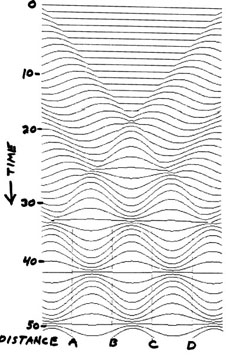Greetings:
During the course of my career in microwave and laser physics I have found
that understanding the complexities of the phenomena of interference in
1, 2, and 3 or more dimensions is one of the most fascinating and
fundamentally important areas in physics and engineering. It aids in
understanding antenna beams and patterns, holograms, radio astronomy
techniques, image processing, synthetic array antennas and imaging radar,
signal processing, earth quakes and mineral exploration, and animal (bats,
moths, whales etc.) and human sonar processing all of which exhibit or use
the principles of interference in different , yet basically similar ways.
However, there are a number of pit falls that the student is likely to
fall into when introduced to interference only in text books without
seeing changes with time. I find visual demonstrations provide insight
that would take many pages of well written text (which I have not yet found).
The simple one dimensional vibrating string provides the best demonstration
for answering your questions. Musical instruments and radio frequency
transmissions lines can all be modeled with this simple experiment. I use
an old 110 volt 60 Hz ac relay coil to vibrate a thin piece of spring steel
at 60 Hz (60 vibrations per second). I tie 3 or 4 feet of fishing line to
the vibrating spring and then anchor the loose end of the string to a
clamp or some other fixture to place the string in tension. By placing the
vibrating string in various states of tension, traveling waves and reflected
waves can be made to collide head on. Indeed you are right, when waves
of similar amplitude and frequency collide head on, constructive and
destructive interference occur in order. This phenomena leads to what
are called standing waves and they can be observed in stringed musical
instruments, in radio frequency transmission lines and in the experiment
above. The points of destructive
interference are called nodes and the node spacing is produced by the
musicians finger work or the strings tension or both.
VIBRATING
PEAK
* * *
***** ***** *****
******** ******* *******
********** ********* *********
********** ********* *********
------------------------------------------STRING
********** ********* *********
********* ********* *********
******* ******* *******
***** ***** *****
* * *
NODE NODE
Thus 2 waves traveling in opposite directions produce a mode pattern that
is fixed along the string. It is difficult to observe or understand how the
standing wave develops; however, the following program in GW BASIC does a
good job of it. The nodes form at distances A,B,C &D in the print out.
The plot line 210 for your PC is computer and Basic software dependent.
It is not easy to see the nodes in the display. To overlay the time plots
to get an accurate picture of the nodes and peaks set T = 300 in Line 10
and M=10 in line 260
 40 REM STANDING WAVES DEVELOPED FROM INTERFERING WAVES
50 REM X RANGE = 0 TO 280, Y RANGE= 0 TO 191
60 REM M SETS Y SPACING
100 M=10
110 T=0
120 TF=(T-X)/20
130 TR=(T-279+X)/20
140 IF TF<0 THEN EF=0:GOTO 160
150 EF=SIN(TF)
160 IF TR<0 THEN ER=0:GOTO 180
170 ER=SIN(TR)
180 E=9*(EF+ER)
190 Y=M-E
200 IF Y>191 GOTO 220
210 PSET (X,Y):REM USE THE PLOT FOR YOUR TYPE OF BASIC
220 X=X+1
230 IF X<280 GOTO 120
240 T=T+8
250 X=0
260 M=M+10
270 IF M<191 GOTO 120
1000 END
40 REM STANDING WAVES DEVELOPED FROM INTERFERING WAVES
50 REM X RANGE = 0 TO 280, Y RANGE= 0 TO 191
60 REM M SETS Y SPACING
100 M=10
110 T=0
120 TF=(T-X)/20
130 TR=(T-279+X)/20
140 IF TF<0 THEN EF=0:GOTO 160
150 EF=SIN(TF)
160 IF TR<0 THEN ER=0:GOTO 180
170 ER=SIN(TR)
180 E=9*(EF+ER)
190 Y=M-E
200 IF Y>191 GOTO 220
210 PSET (X,Y):REM USE THE PLOT FOR YOUR TYPE OF BASIC
220 X=X+1
230 IF X<280 GOTO 120
240 T=T+8
250 X=0
260 M=M+10
270 IF M<191 GOTO 120
1000 END
I'll try and add a picture here of the program output in JPEG however, this is
my first try at incorporating a picture in an answer and it may not work.
Regards, your Mad Scientist
Adrian Popa
Current Queue |
Current Queue for Physics |
Physics archives
Try the links in the MadSci Library for more information on Physics.
MadSci Home | Information |
Search |
Random Knowledge Generator |
MadSci Archives |
Mad Library | MAD Labs |
MAD FAQs |
Ask a ? |
Join Us! |
Help Support MadSci
MadSci Network
© 1997, Washington University Medical School
webadmin@www.madsci.org
 40 REM STANDING WAVES DEVELOPED FROM INTERFERING WAVES
50 REM X RANGE = 0 TO 280, Y RANGE= 0 TO 191
60 REM M SETS Y SPACING
100 M=10
110 T=0
120 TF=(T-X)/20
130 TR=(T-279+X)/20
140 IF TF<0 THEN EF=0:GOTO 160
150 EF=SIN(TF)
160 IF TR<0 THEN ER=0:GOTO 180
170 ER=SIN(TR)
180 E=9*(EF+ER)
190 Y=M-E
200 IF Y>191 GOTO 220
210 PSET (X,Y):REM USE THE PLOT FOR YOUR TYPE OF BASIC
220 X=X+1
230 IF X<280 GOTO 120
240 T=T+8
250 X=0
260 M=M+10
270 IF M<191 GOTO 120
1000 END
40 REM STANDING WAVES DEVELOPED FROM INTERFERING WAVES
50 REM X RANGE = 0 TO 280, Y RANGE= 0 TO 191
60 REM M SETS Y SPACING
100 M=10
110 T=0
120 TF=(T-X)/20
130 TR=(T-279+X)/20
140 IF TF<0 THEN EF=0:GOTO 160
150 EF=SIN(TF)
160 IF TR<0 THEN ER=0:GOTO 180
170 ER=SIN(TR)
180 E=9*(EF+ER)
190 Y=M-E
200 IF Y>191 GOTO 220
210 PSET (X,Y):REM USE THE PLOT FOR YOUR TYPE OF BASIC
220 X=X+1
230 IF X<280 GOTO 120
240 T=T+8
250 X=0
260 M=M+10
270 IF M<191 GOTO 120
1000 END